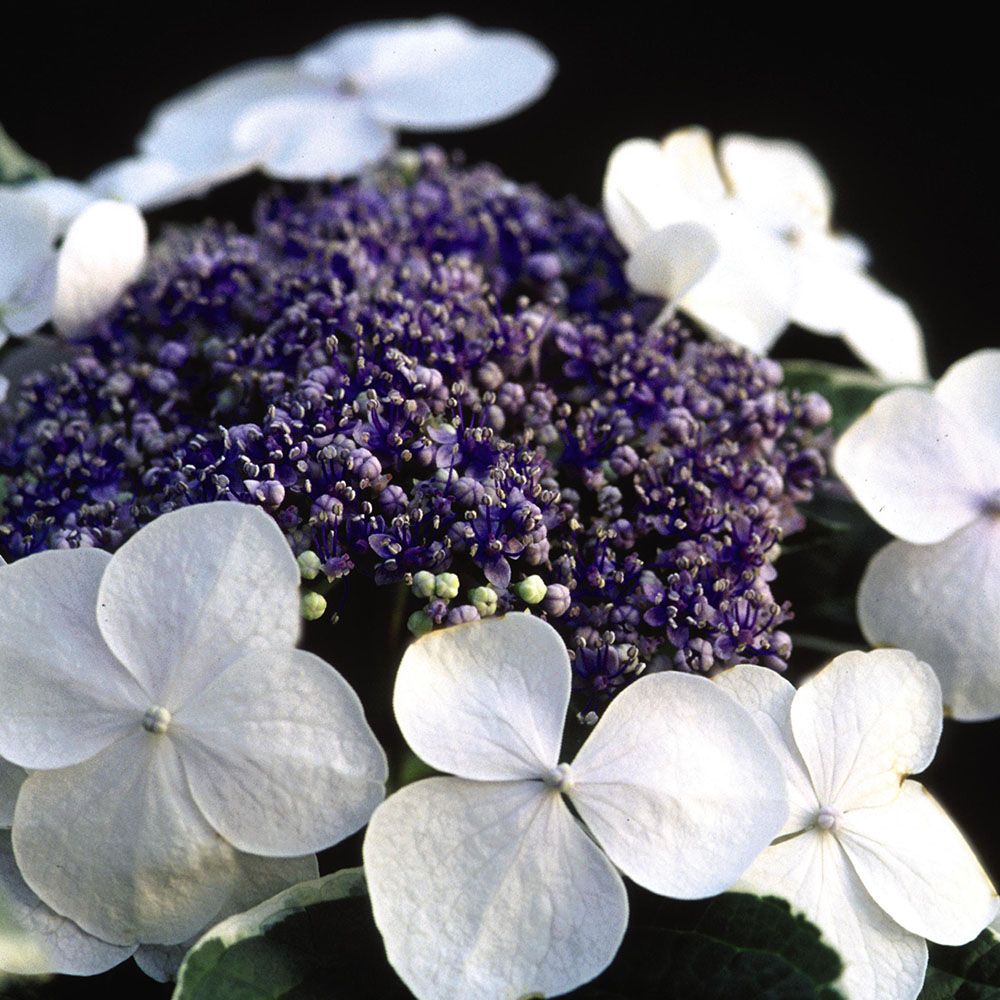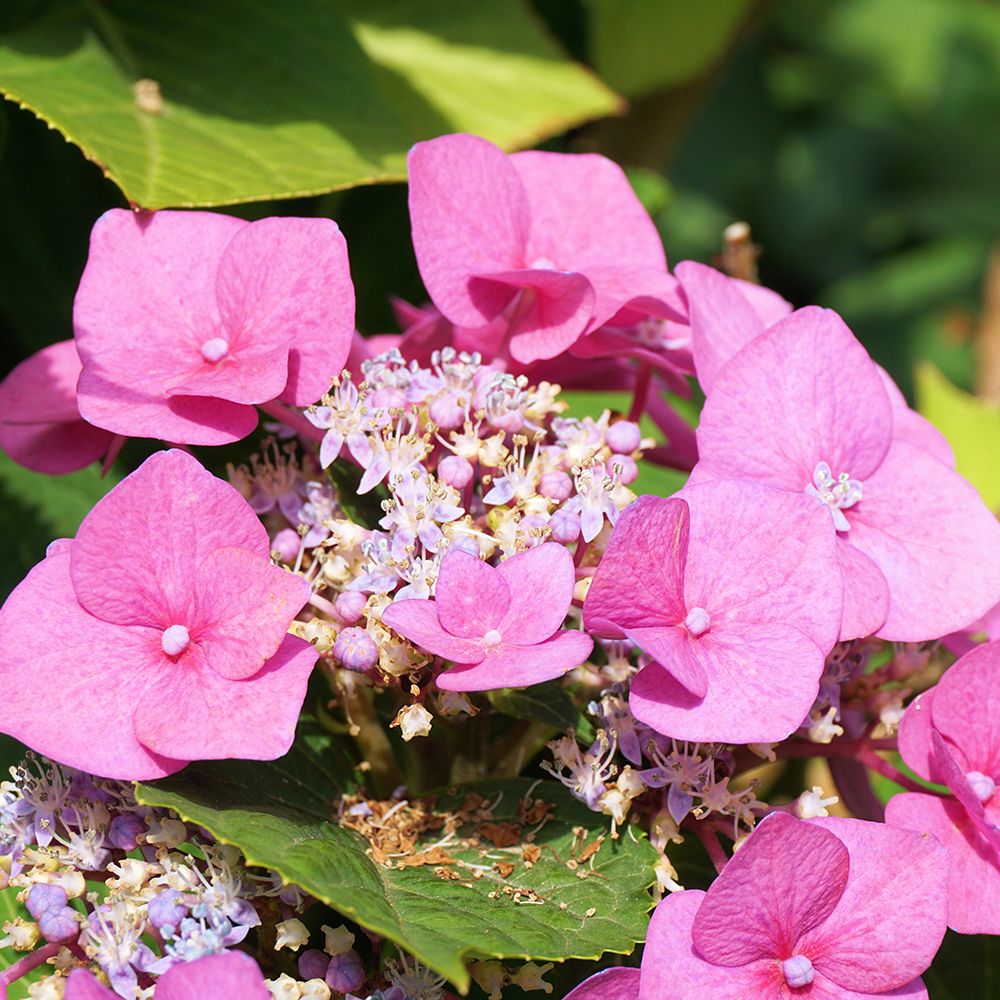There are 5 main types of hydrangeas that you will find in North America. We've made this ultimate guide to help you identify hydrangeas easily by looking at images for reference as well as main characteristics that each type commonly have. Click through on each type for more detailed information. Also, there is an easy guide at the bottom of this article to quickly read through the information.
1. Bigleaf Hydrangeas | Hydrangea macrophylla
Also called French hydrangeas, florist's hydrangeas, & hortensia. This is the most common type of hydrangea found in the United States. There are 3 different types of hydrangea macrophylla; mophead, lacecap and mountain hydrangeas. Some mophead hydrangeas will do fine in colder areas as long as the winter is not too cold and dry. The condition hydrangeas are most sensitive to is being exposed to a freeze after an extended warm spell. In those areas, additional protection may be required.
I. Mophead Hydrangeas | Hydrangea macrophylla

These are the most popular bigleaf hydrangea. Many recognize these due to their large flower heads that are purple, blue and pink. In general, mophead and lacecap leaves are relatively thick and crisp, somewhat shiny, and often heart-shaped. Their edges are coarsely toothed. They are approximately 4"-6" long and 3"-5" wide, but in some cases, they may grow even larger. Leaf stems (petiole) are short, causing the leaves to hug close to the main stems in most cases. Stems often have tiny black or red streaks or speckles. Mopheads and lacecaps have identical leaf forms.
II. Lacecap Hydrangeas | Hydrangea macrophylla normalis

The scientific name for lacecap hydrangeas is Hydrangea macrophylla normalis. Lacecaps are identical to mopheads in every way except the shape of their blooms. The little buds in the center of the lacecap are the fertile flowers, and the large showy blossoms around the outer edge are the sterile flowers.
III. Mountain Hydrangeas | Hydrangea macrophylla Serrata

The scientific name for mountain hydrangeas is Hydrangea macrophylla ssp. serrata. These are the least common bigleaf hydrangea. These have much smaller flowers but the plants are extremely hardy and built to survive harsh winters and climates.
2. Panicle hydrangeas | Hydrangea paniculata

Panicle hydrangeas are known for their cone shaped flower heads. These are large blooms typically start white and may turn to pink. These are the most cold hardy hydrangea and can grow from zones 3 to 7. All the paniculatas are very cold hardy and can be grown as far north as Zone 3a. Most of the paniculatas grow equally well in the south. However, the variety H. paniculata 'Grandiflora' does best in cooler climates.
The leaves of PG hydrangeas are relatively easy to identify when compared with other hydrangeas. They are smaller, thinner, and rougher than leaves of the mophead hydrangea, typically 3"-6" long and 3"-4" wide. The edges are finely toothed in some varieties and more coarsely toothed in others. They are medium green with a matt finish.
One feature that will aid in identification of the H. paniculata is this: three leaves grow from a stem-node and are distributed around the node in a whorl.
PG hydrangeas are the only hydrangeas that will form trees. Their central stem(s) can be developed into very attractive trunks.
3. Smooth Hydrangeas | Hydrangea arborescens

These are also called wild hydrangeas, these shrubs are native to the United States. These bushes can tolerate hotter climates and are hardy from zones 4 to 7. These are sometimes planted as hedges because of their size. The leaves of arborescens are generally heart shaped, thin, and floppier than the mopheads (macrophylla). They have a matte surface and a coarser texture than the smooth leaf of the mophead. The leaf stems (petiole) are long and hold the leaf away from the main stem. Smooth hydrangeas should be grown more often, because these do fantastic in both warm and cold climates.
Annabelle hydrangea is the most well-known variety and is a very cold hardy hydrangea that looks somewhat like a mophead. It is white and ages to an attractive light green color. It can grow as far north as Zone 3a. Recently, there has been a new and improved version of Annabelle called Incrediball hydrangea. It's relatively the same plant, but with improved stem strength to hold up the blooms, and it flowers more profusely.
4. Oakleaf Hydrangeas | Hydrangea quercifolia

It is easy to see where the Oakleaf Hydrangea gets its name. It's leaves are shaped much like those of a red oak. The leaves can be 4" X 4" or they can be a huge 10" X 10." The foliage on these hydrangeas also changes color in the fall and are the only type of hydrangeas that do that. The color will change from orange to red to mahogany. This is a beautiful hydrangea that makes a dramatic show in the spring and will grow in light shade or mostly sun. It will grow unprotected in cooler areas than the above macrophylla (mopheads and lacecaps).
Some authorities say it is hardy through Zone 4b/5a. One other requirement for the oakleaf is that it must have very sunny, relatively hot summers to bloom well. In addition, it does not do well in areas that stay continuously moist. Learn more about the Oakleaf hydrangea.
5. Climbing Hydrangeas | Hydrangea petiolaris

These are easy to spot because they are actually vines. Climbing hydrangeas are native to Asia (Japan, Korea and Siberia) and can grow in zones 4 to 8 and are becoming more popular due to the uniqueness of growing up structures and having large blooms. Also called Hydrangea petiolaris, these can grow 30 to 80 feet long.
Another climbing hydrangea is the Japanese false-hydrangea vine, which will grow 15 to 30 feet high. The botanical name for those is Schizophragma hydrangeoides and this plant is native to Japan. These are not actually considered hydrangeas though, the plants and lacecap flowers just closely resemble hydrangeas.
- Hydrangea macrophylla
- Mophead
- Lacecap
- Mountain
- Hydrangea paniculata
- Hydrangea quercifolia
- Hydrangea arborescens
- Hydrangea petiolaris
